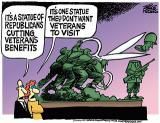Oct. 29, 2011 - When he enlisted in the U.S. Air Force during his senior year of high school, Larry Fry was a sheltered 18-year-old teenager from a small Pennsylvania town.
Patriotic and fascinated by the stories his brother told him about his service in the Air Force, he enlisted in 1960 having no idea, of course, that in January 1962, he would be in Vietnam while Agent Orange was being sprayed. The defoliant was used as part of Operation Ranch Hand and killed trees, leaving them without leaves, standing skeletons, "like winter," Fry recalled, so the enemy couldn't hide in the thick leaves.
"It raised hell with the environment," Fry said, discussing it in the living room of the Ocean Pines home he shares with his wife, Jean. The two were drawn to the Pines seven years ago because of their interest in bird-watching.
He and about nine others were staying in tents with a wooden platform as a floor and sleeping on metal cots when they noticed barrels with orange stripes, identifying the contents as Agent Orange.
"Nobody ever said, 'This stuff is dangerous.' They sprayed it to the edge of the base, several hundred yards away. You couldn't smell anything," Fry said, recalling it was used from 1962 into the 1970s.
He was exposed to it 70 days.
After the war, troops started to develop various medical problems, but the defense department and Veterans Administration both refused to accept blame. Congress then became involved and passed a law stating the United States would take responsibility for diseases related to exposure to Agent Orange, even if they were in Vietnam only one day. read more>>>























No comments:
Post a Comment